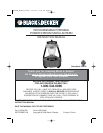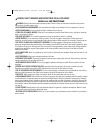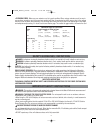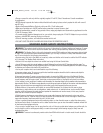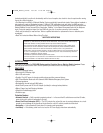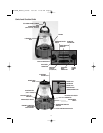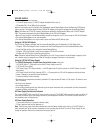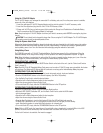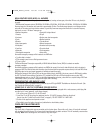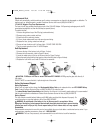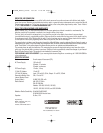
3
• Charge or power this unit only with the originally supplied 12 volt DC, Class 2 transformer. Consult manufacturer
for replacement.
• NEVER attempt to operate the Lantern without the bulb and housing in place; and only replace the bulb with a new 9
watt CFL bulb.
• Replace the Removable Battery Pack only with a new 3Ah, 12 volt battery pack.
• Make sure all switches are in the OFF position before connection to a power source or load.
• When left unattended or unused for long periods of time, unplug any adapters and disconnect any appliances from the
12 Volt DC Accessory Outlet.
• To prevent possible electrical damage to unit or your vehicle, always unplug the 12 Volt DC Adapter from your vehicle’s
accessory outlet BEFORE removing the plug from the unit.
• Follow all warnings, cautions, and instructions marked on this unit.
• THIS UNIT IS NOT FOR USE BY CHILDREN AND SHOULD ONLY BE OPERATED BY ADULTS.
WEATHER RADIO SAFETY INSTRUCTIONS
WARNING: This product should not be the only source of information for all-hazard, watches and warnings. If severe
weather is imminent; do not wait to receive the weather alert warning, take precautionary measures to protect yourself.
WARNING: The Weather Radio in this unit is designed to receive NOAA weather and other emergency alerts as listed
on page 12 of this manual and communicate these alerts to you. You may not receive or clearly hear these alerts under
any of, but not limited to, the following circumstances:
• Improper setup (Unit not in Alert Mode, or turned on); make sure that the unit is turned on and the Alert LED indicator
is lit, (see page 7 for Weather Radio instruction).
• Volume is too low; adjust the volume to an audible level using the Volume Control Knob.
• Loss of AC power and/or the internal batteries are dead. Recharge the unit using the DC charging method on page 7 or
using the AC charging method on page 6 following return of AC power. Be sure to occasionally place the unit back on charge
to maximize your runtime in the event of AC power failure.
• Lost or poor reception which can be attributed to any of the following:
a) Improper antenna setup. To ensure you get the best available reception extend the built-in antenna and adjust its
direction to provide maximum reception.
b) Improper tuner setup. To ensure you are always tuned in to receive the NOAA alerts check the National Weather
Service website @ http://www.nws.noaa.gov/nwr/nwrbro.htm for the signal frequency in your area. If you are on the
correct frequency and fail to get a signal, check that you have power and/or try placing the radio close to a window.
c) Your location is out of range from a weather radio transmitter; the broadcast range from the weather radio transmitter is
approximately 40 miles. The effective range depends on such things as terrain and quality of the receiver and indoor/outdoor
antenna. Log onto http://www.nws.noaa.gov/nwr/nwrbro.htm to see which frequency best serves your area.
d) Metal structure; to improve the radio’s ability to receive NOAA broadcast; do not place the unit near any large
obstructions or metal surfaces such as refrigerators, metal cabinets, etc. In metal structures, such as mobile homes,
reception is difficult because the metal structure impedes the transmission of monitor waves, in this case, place the
radio close to a window to improve reception.
e) Radio frequency interference; some electronics may cause radio frequency interference such as two-way radios,
remote control cars, etc. Place the unit as far away as possible from these devices or avoid the usage of devices that
cause radio frequency interference while the unit is in alert mode.
• If there is excessive background noise while monitoring alerts; or when the alert comes on, adjust the volume using
the Volume Control Knob or relocate the unit to a better location where you can hear the weather broadcast without risk
of interference from background noise.
• If you are out of audible range of or far away from the unit; or if there is an obstruction between you and the radio, be
sure to check the unit for warnings periodically or remain close enough (within hearing range) to clearly hear and
understand the alerts.
WARNING: To ensure to continuously monitor alerts from NOAA while the unit is in alert mode, the unit should be
PS50LRB_Manual_120106 12/1/06 11:25 AM Page 3



